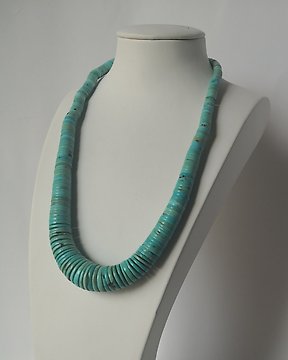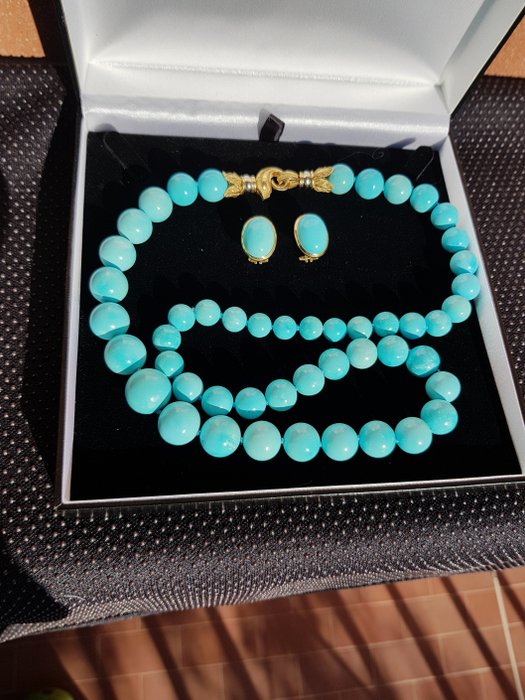
18 kt. Yellow gold - Earrings, Necklace, Set Turquoise
No. 18622877

No. 18622877

Fine set of luxury jewellery, composed of a necklace with hard semi-precious turquoise stones increasing in size, natural and vintage, top quality (origin: Iran, 1960s). The beads increase in size, beginning from smallest (diameter 9.76 mm) to the largest (diameter 15.95 mm). Necklace length: 70 cm. The beads on the necklace are separated by a small knot to make sure that the turquoise beads cannot rub against each other (the turquoise, being a phosphate, can get damaged over time). Very intense light blue turquoise (no greenish marks, which are typical of antique turquoise affected by copper oxide). Necklace embellished by a large (and heavy) handmade 18 kt yellow and white gold clasp. The 18 kt gold clasp was made in the 1980s in Valenza Po (AL), specifically for this necklace by the famous master goldsmith Bissolo Amerigo. Included in the set there are two large earrings with the same type of antique turquoise, cabochon cut, handmade with 18 kt yellow gold frames. Weight of the two earrings in 18 kt yellow gold: 10.45 g. Dimensions: width 20.24 mm, height 25.15 mm.
In order to understand the value of this fine variety of turquoise, remember that turquoise is semi-precious hard stone which has been used since ancient times (just think back to the pre-Colombian turquoise jewels or the light blue scarabs on many tombs of the Egyptian pharaohs). Many turquoise jewels and fine ornamental objects which belonged to the pharaohs, even after 2000 years have reached us in absolutely perfect condition. As beautiful as they were twenty centuries ago. The natural Persian turquoise (now impossible to find) is sold by weight (like precious metals or fine coral), and by the gram it costs much more than gold. Be careful not to confuse natural antique turquoise with reconstituted turquoise (or paraffinated turquoise paste), which is obtained by agglomerating the resins and the remnants from processing the turquoise. The last type of turquoise mentioned is a completely different thing, and it can be found at affordable prices. Ultimately, remember that genuine natural turquoise does not have a perfectly uniform light blue colour (that is "turquoise paste", which is reconstructed and coloured in a laboratory with cobalt blasts), but a streaked celestial colour, and you can see the inclusions of phosphate (streaks of white). Like genuine Russian imperial jade (which is not completely green, but streaked with specks of black), or like angel skin coral (which is not completely pink, but has inclusions of white), or the best Iranian lapis lazuli (which is not completely blue, but has inclusions of pyrite which give it a gold glow).
How to buy on Catawiki
1. Discover something special
2. Place the top bid
3. Make a secure payment